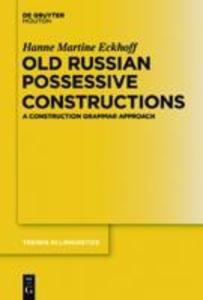This book is a detailed study of the possessive semantic space within the framework of construction grammar. Using corpus data from Old Church Slavonic and Old Russian, the book uses semantic maps to document the relationship between form and meaning in a set of semantically closely related syntactic constructions that can all express adnominal possession and all partially overlap. The book also traces the development of these constructions from the earliest Slavic attestations towards Modern Russian, thus also using the semantic maps as a diachronic tool.
This approach results in a much improved analysis of the data at hand: The competing possessive constructions are treated as partly synonymous constructions in the same semantic space. Changes are then seen to follow paths in this space. The constructionist perspective also allows discerning the relative contributions of the possessor nominal, the possessee nominal and properties of the constructions themselves.
The book is a contribution to Slavic historical linguistics, to the general understanding of adnominal possession and to forwarding functionalist approaches to syntactic change.
Inhaltsverzeichnis
1;Acknowledgements;9 2;List of abbreviations;11 3;1 Introduction;13 3.1;1 Possession and its neighbours;13 3.2;2 The case study;13 3.2.1;2.1 Earlier approaches;14 3.2.2;2.2 The text samples;17 3.3;3 Why construction grammar?;18 3.4;4 Semantic maps;20 3.5;5 A path through the book;21 4;2 A map of the possessive semantic space;23 4.1;1 Where does the meaning come from?;23 4.2;2 Relational nouns and slot fillers;24 4.2.1;2.1 Deverbal nouns;26 4.2.2;2.2 Other relational nouns;27 4.3;3 Construction meaning: reference points and intrinsic relationships;29 4.4;4 The nodes;31 4.4.1;4.1 Identification (ID and ID(slot)): Reference points on instance level;32 4.4.2;4.2 TYPE: Reference points on type level;33 4.4.3;4.3 LABEL: Strongly conventionalised constructions;34 4.4.4;4.4 Elaboration of relational nouns: ELAB(slot) and ELAB(part);35 4.4.5;4.5 Elaboration of non-relational nouns (ELAB);37 4.5;5 Meaning to form or form to meaning;38 4.6;6 Semantic maps;38 4.6.1;6.1 What does a semantic map show us?;38 4.6.2;6.2 Drawing vs. generation;39 4.6.3;6.3 A correspondence analysis plot;40 4.7;7 The working map;42 5;3 The constructions in Old Russian;47 5.1;1 Denominal adjectives;47 5.1.1;1.1 ADJ1: True possessives;48 5.1.2;1.2 ADJ2: Relative adjectives;51 5.2;2 The genitive;53 5.3;3 The dative;58 5.4;4 Mixed constructions;61 5.5;5 OCS and Old Russian;61 5.6;6 Summary;63 6;4 ID: Reference points on instance level;65 6.1;1 OCS;65 6.1.1;1.1 ID;65 6.1.2;1.2 ID(slot);71 6.2;2 11th14th century Old Russian;80 6.2.1;2.1 ID;80 6.2.2;2.2 ID(slot);86 6.3;3 Further developments in the history of Russian;93 6.3.1;3.1 The ADJ1 construction;94 6.3.2;3.2 The ADJ2 construction;97 6.3.3;3.3 The genitive constructions;99 6.3.4;3.4 The dative construction;101 6.3.5;3.5 Mixed constructions;101 6.3.6;3.6 A snapshot of the 18th century: When did the genitive start expanding?;103 7;5 The ELAB nodes: Intrinsic relationships;105 7.1;1 Reference points or not?;105 7.2;2 ELAB(slot);107 7.2.1;2.1 OCS;107 7.2.2;
2.2 11th14th century Old Russian;116 7.2.3;2.3 Further developments in the history of Russian;123 7.3;3 ELAB(part);127 7.3.1;3.1 ELAB(part) in OCS and 11th14th century Old Russian;127 7.3.2;3.2 Further developments in the history of Russian;129 7.4;4 ELAB;130 7.4.1;4.1 ELAB in OCS and 11th14th century Old Russian;130 7.4.2;4.2 Further developments in the history of Russian;138 7.5;5 Conclusions;142 8;6 Types and conventionalised units: TYPE and LABEL;143 8.1;1 TYPE;143 8.1.1;1.1 TYPE in OCS and 11th14th century Old Russian;144 8.1.2;1.2 Borderline cases;146 8.1.3;1.3 Further developments in the history of Russian;146 8.2;2 LABEL;147 8.2.1;2.1 OCS;148 8.2.2;2.2 11th14th century Old Russian;152 8.2.3;2.3 Further developments in the history of Russian;156 8.3;3 Conclusions;160 9;7 Synchrony and diachrony;163 9.1;1 Synchrony: Division of labour vs. complementary distribution;163 9.1.1;1.1 Complementary distribution?;164 9.1.2;1.2 Division of labour;165 9.1.3;1.3 Map and territory;167 9.2;2 Diachrony;168 9.2.1;2.1 OCS vs. Old Russian;168 9.2.2;2.2 Development trends;169 9.2.3;2.3 The demise of the dative construction;170 9.2.4;2.4 The withdrawal of the ADJ2 construction;173 9.2.5;2.5 The weakening of the ADJ1 construction;174 9.2.6;2.6 From two genitive constructions to one?;180 9.2.7;2.7 A brief note on origins and causes;183 9.2.8;2.8 Diachronic paths;185 10;8 Concluding remarks;191 11;Appendix: Corpus and method;193 11.1;1 Text selection principles;193 11.1.1;1.1 Fair representation of each period;193 11.1.2;1.2 Geography;194 11.1.3;1.3 Literary genres;194 11.1.4;1.4 Text editions and manuscripts;194 11.1.5;1.5 Late copies of early manuscripts;195 11.2;2 The Old Russian text samples;197 11.2.1;2.1 Text genres;197 11.2.2;2.2 Periodisation of Old Russian texts;198 11.3;3 The OCS text sample;199 11.4;4 Excerpation, data registration and citation;200 11.5;5 Text excerpts;202 11.5.1;5.1 Old Russian;202 11.5.2;5.2 OCS;207 12;Notes;209 13;References;217 14;Index;225
